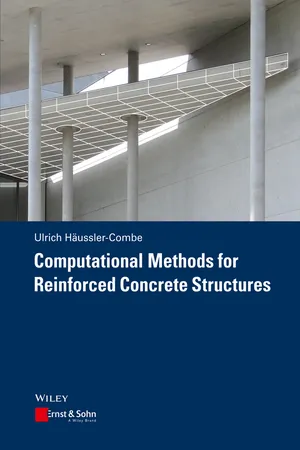
- English
- ePUB (mobile friendly)
- Available on iOS & Android
Computational Methods for Reinforced Concrete Structures
About This Book
The book covers the application of numerical methods to reinforced concrete structures. To analyze reinforced concrete structures linear elastic theories are inadequate because of cracking, bond and the nonlinear and time dependent behavior of both concrete and reinforcement. These effects have to be considered for a realistic assessment of the behavior of reinforced concrete structures with respect to ultimate limit states and serviceability limit states.
The book gives a compact review of finite element and other numerical methods. The key to these methods is through a proper description of material behavior. Thus, the book summarizes the essential material properties of concrete and reinforcement and their interaction through bond. These basics are applied to different structural types such as bars, beams, strut and tie models, plates, slabs and shells. This includes prestressing of structures, cracking, nonlinear stressstrain relations, creeping, shrinkage and temperature changes.
Appropriate methods are developed for each structural type. Large displacement and dynamic problems are treated as well as short-term quasi-static problems and long-term transient problems like creep and shrinkage. Most problems are illustrated by examples which are solved by the program package ConFem, based on the freely available Python programming language. The ConFem source code together with the problem data is available under open source rules at concrete-fem.com.
The author aims to demonstrate the potential and the limitations of numerical methods for simulation of reinforced concrete structures, addressing students, teachers, researchers and designing and checking engineers.
Frequently asked questions
Information
Chapter 1
Finite Elements Overview
1.1 Modeling Basics

Table of contents
- Cover
- Contents
- Title page
- Copyright page
- Preface
- Notations
- Chapter 1: Finite Elements Overview
- Chapter 2: Uniaxial Structural Concrete Behavior
- Chapter 3: Structural Beams and Frames
- Chapter 4: Strut-and-Tie Models
- Chapter 5: Multiaxial Concrete Material Behavior
- Chapter 6: Plates
- Chapter 7: Slabs
- Chapter 8: Shells
- Chapter 9: Randomness and Reliability
- Appendix A: Solution of Nonlinear Algebraic Equation Systems
- Appendix B: Crack Width Estimation
- Appendix C: Transformations of Coordinate Systems
- Appendix D: Regression Analysis
- Appendix E: Reliability with Multivariate Random Variables
- Appendix F: Programs and Example Data
- Bibliography
- Index